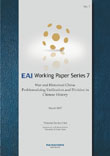
War and Historical China: Problematizing Unification and Division in Chinese History, War and Historical China: Problematizing Unification and Division in Chinese History
중국의 미래 성장과 아태 신문명 건축 | 워킹페이퍼 | 2007-04-04
Victoria Tin-bor Hui
EAI Fellows Program Working Paper Series No.7
요약문
This paper examines the unity paradigm which holds that unification has been the normal and natural course of Chinese history, and that unification has nurtured stability and prosperity while division has generated chaos and sufferings. I highlight that the Chinese term for China, “zhongguo,” originally meant “central states” in plurality. I develop a rigorous definition of unification and show that zhongguo was more often divided than unified. I also demonstrate that unification was not a natural development but a contingent outcome of war. Because unification had to be achieved by conquest, eras of division tended to be marked by conflicts and sufferings. Before Qin’s wars of unification, however, the classical era witnessed stability, liberty, and prosperity. In the post-Qin era, division remained favorable to liberty and prosperity while unification stifled both. This contrast is more pronounced if we extend the analysis from the Chinese heartland to the periphery.
저자
Victoria Tin-bor Hui is an Assistant Professor in Political Science at the University of Notre Dame. Her research examines the dynamics of international politics, the origins of constitutional democracy, and the development of trade and capitalism in the broad sweeps of history, with a special focus on historical China and historical Europe. She is the author of War and State Formation in Ancient China and Early Modern Europe (Cambridge University Press, 2005).
 본 working paper는 미국 헨리루스재단의 지원을 받은 "EAI Fellows Program on Peace, Governance, and Development in East Asia"에 제출된 논문이며, 온라인 버전으로만 배포됩니다.
본 working paper는 미국 헨리루스재단의 지원을 받은 "EAI Fellows Program on Peace, Governance, and Development in East Asia"에 제출된 논문이며, 온라인 버전으로만 배포됩니다.
Chinese take for granted China’s “historical oneness.”1 They hold the belief that China or zhongguo refers to a natural territorial and cultural polity with five thousand years of history. Chinese leaders and intellectuals often insist that unification is a sacrosanct value and assert that “prosperity and development are associated with unity, while war and conflict come with separation.”2 Beijing’s “One China” policy is a modern variant of the classical da yitong or “great unity” paradigm.3 As the Lushi chunqiu, a Warring States text, puts it, “There is no turmoil greater than the absence of the Son of Heaven; without the Son of Heaven, the strong overcome the weak, the many lord it over the few, they incessantly use arms to harm each other.”4 The modern argument refers to the interlocking claims that, although there were eras of division in Chinese history, unification has been the norm, unification after division has been the natural course of historical development, and unification has nurtured stability and prosperity while division has generated chaos and sufferings.
As the unity paradigm seeks authority in history, this paper examines its historical foundation. In tracing Chinese history in the longue duree, I follow the prospective approach and avoid the retrospective perspective.5 That is, I proceed from China’s formative era and search forward for alternative paths and outcomes, instead of viewing the past through the prism of the present. In addition, I follow R. Bin Wong’s “symmetrical perspectives”6 and juxtapose Sinocentric perspectives against Eurocentric perspectives. This does not mean that I naively apply Eurocentric theories to judge (or misjudge) Chinese history. Rather, I analyze if insights from comparative and world history shed light on actual developments in historical China.
This paper is composed of two main sections. In the first section, I address the claim that unification has been the normal and natural course of Chinese history. I problematize the conventional understanding of historical China and develop a precise definition of unification. It is too often overlooked that the very term “China” or “zhongguo” has significantly evolved in Chinese history. Just as the term “Germany” (or any other country) involves a “troubled, contingent history” rather than a polity with “distinctive, enduring characteristics,”7 zhongguo does not entail an unchanging territorial space or a single culture. This term acquired the modern meaning of nation-state only in the late nineteenth century.8 Zhongguo originally referred to “central states” -- in plural form -- in the Spring and Autumn and Warring States periods (656-221 BC). Although Qin unified this international sys-tem in 221 BC, the Qin empire and subsequent dynasties invariably broke down. In the post-Qin era, zhongguo referred to dynasties that controlled the central plain in northern China...(Continued)
미중관계와 한국
중국의 미래 성장과 아태 신문명 건축
워킹페이퍼
[22대 총선 연구 시리즈] 제22대 국회의원선거와 분할투표 양상
이한수 | 2007-04-04
워킹페이퍼
[22대 총선 연구 시리즈] 대통령 국정운영 평가와 제22대 국회의원 선거
성예진 | 2007-04-04